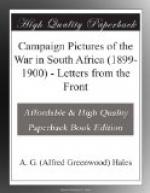Turning my eyes towards the valley behind our position, I saw that we intended to try to turn the enemy’s left flank. Little squads of mounted men, 95 in each group, swept along the valley at a gallop. They were the Yeomanry and mounted infantry, and numbered about 600. A more workmanlike body of fellows it would be hard to find anywhere. They sat their horses with easy confidence, and looked full of fight. Some of them carried their rifles in their hands, muzzle upwards, the butt resting on the right thigh; others had their guns slung across their shoulders. Group after group went eastward, and the Boers knew nothing of the movement, because we were for once employing their own tactics. I watched them out of sight, and then turned my attention to the guns. There was very little time wasted by our people. The gunners on our left flank poured in a heavy fire, the centre took up the chorus, and the guns on the right repeated it. For miles along their front the Boers must have been in deadly peril. We seldom saw them. Now and again a group of roughly clad horsemen would flash into view and disappear again as if by magic, with shells hurtling in their wake. Our artillery could not locate their main force with any degree of certainty, nor could they place us properly. They were not idle; their guns, of which they had a decent number, sought for our position with dauntless perseverance. Their shells soon began to drop amongst us, but they did no harm at all. They fell close enough to our troops in many instances, but they were so badly made that they would not explode, or if they did they simply fizzed, and were almost as harmless as seidlitz powders.
The spiteful little pom-poms cracked away and kept us on the alert, until one grew weary of the everlasting noise of cannon. At mid-day, tired of the monotony of the game, I turned my horse’s head towards camp, and, in company with three other correspondents, soon sat down to a lunch of mealies and boiled fowl; but we were destined not to enjoy that meal, for before the first mouthful had left my plate there came a wailing howl through the air, then a strange jarring noise, and a shell plunged into the earth forty yards away from the tent. A few minutes later another visitor from the same direction crashed on top of one of the transport waggons within a stone’s throw of our tent. That decided me; in a few seconds I had scrambled up the side of a kopje, with the leg of a fowl in one hand and a soldier’s biscuit in the other. The shells had not burst, but no man could say when one would, and I had no particular interest in regard to the inside of any shell myself. I was not the only one who made a hasty exit from the camp; in ten seconds the side of the kopje was alive with men. The shells continued to fall right amongst the waggons every few minutes for over two hours; yet only one man was killed, a negro driver being the victim, a shell dropping right against his thigh. The range of the Boer gun was absolutely




